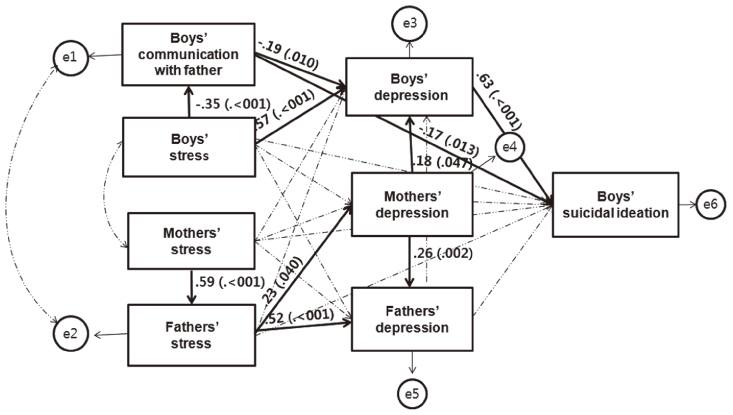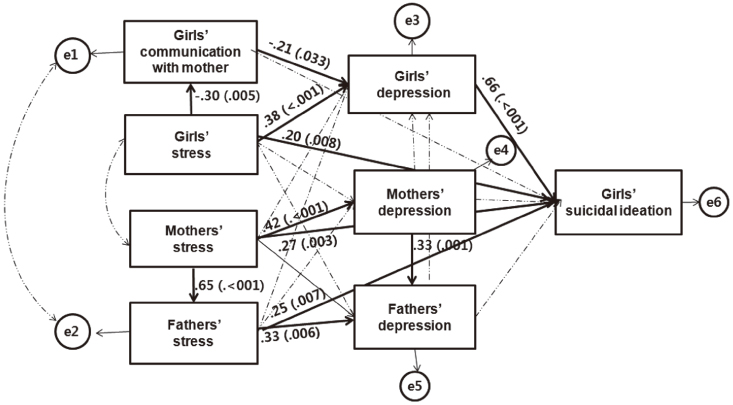J Korean Acad Nurs.
2014 Jun;44(3):317-327. 10.4040/jkan.2014.44.3.317.
Comparison of Boys' and Girls' Families for Actor and Partner Effect of Stress, Depression and Parent-Adolescent Communication on Middle School Students' Suicidal Ideation: Triadic Data Analysis
- Affiliations
-
- 1College of Nursing Science and East-West Research Institute, Kyung Hee University, Seoul, Korea. sunghshin@khu.ac.kr
- 2Department of Preventive Medicine, School of Medicine, Kyung Hee University, Seoul, Korea.
- KMID: 1796156
- DOI: http://doi.org/10.4040/jkan.2014.44.3.317
Abstract
- PURPOSE
This study was done to compare families of boys or of girls for actor and partner effect of stress, depression and parent-adolescent communication as perceived by mother, father and adolescent on adolescents' suicidal ideation.
METHODS
Participants were 183 families (104 boys' families, 79 girls' families) who met eligibility criteria. All measures were self-administered. Data were analyzed using SPSS 18.0 and AMOS 18.0 program.
RESULTS
In boys' families, boys' depression and communication with father showed actor effect on boys' suicidal ideation. Boys' stress showed indirect effect on boys' suicidal ideation through communication with father and boys' depression. Mothers' depression showed indirect partner effect on boys' suicidal ideation through boys' depression. In families of girls, girls' depression and stress showed actor effects on girls' suicidal ideation. Girls' communication with mother showed indirect effects through girls' depression. Also girls' stress showed indirect effect through girls' depression. Stress in mothers and/or fathers showed partner effect on girls' suicidal ideation.
CONCLUSION
To intervene in adolescents' suicidal ideation and promote adolescents' mental health, programs should be developed differently according to gender and based on parent's psychological states.
Keyword
MeSH Terms
Figure
Cited by 1 articles
-
The Differences in Obesity Rates According to Status of Co-Residence with Their Parents in Korean Adolescents: The Implication of the Gender of Single Parent Living with Adolescents
Nahee Kim, Young Gyu Cho, Jae-Heon Kang, Hyun Ah Park, Kyoungwoo Kim, Yang-Im Hur, Duho Kwon
Korean J Health Promot. 2018;18(4):177-183. doi: 10.15384/kjhp.2018.18.4.177.
Reference
-
1. Kim G, Ahn J, Ha K, Lee CH, Woo JM, Lee JK, et al. National evidence-based collaborating agency (NECA) round-table conference consensus statement: Multidisciplinary responses to suicide, the first ranked cause of death in adolescents. J Korean Med Assoc. 2013; 56(2):111–119. http://dx.doi.org/10.5124/jkma.2013.56.2.111.2. Hong YS. The effects of life stress and social support for adolescent suicidal ideation. Korean J Clin Soc Work. 2005; 2(1):249–272.3. Korea Youth Counseling Institute. Report No.: 2007 Youth Counseling Research 134. Adolescent suicide prevention and countermeasure. Seoul: Author;2007.4. Chung HK, Ahn OH, Kim KH. Predicting factors on youth suicide impulse. Korean J Youth Stud. 2003; 10(2):107–126.5. Oh HA, Park YR, Choi MH. The effects of parent-adolescent communication and depression on suicide ideation. J Korean Acad Child Health Nurs. 2008; 14(1):35–43.6. Lee JY, Kim HC, Hyun MH. The relationship of stress, parent-adolescent communication and suicide ideation among adolescent. Korean J Health Psychol. 2005; 10(4):375–394.7. Kim JM. The relationship between school-related stress and depression in adolescents: Examining the mediating effects of perfectionism, self-esteem, and gender differences. Korean J Couns. 2010; 11(2):809–829.8. Reinherz HZ, Tanner JL, Berger SR, Beardslee WR, Fitzmaurice GM. Adolescent suicidalideation as predictive of psychopathology, suicidal behavior, and compromised functioning at age 30. Am J Psychiatry. 2006; 163(7):1226–1232. http://dx.doi.org/10.1176/appi.ajp.163.7.1226.9. Park BK. Family factors related to adolescents' suicidal ideation : Mediating effects of self-esteem and depression. J Hum Ecol. 2007; 11(1):1–17.10. Hammen C, Brennan PA. Severity, chronicity, and timing of maternal depression and risk for adolescent offspring diagnoses in a community sample. Arch Gen Psychiatry. 2003; 60(3):253–258.11. Evans E, Hawton K, Rodham K. Factors associated with suicidal phenomena in adolescents: A systematic review of population-based studies. Clin Psychol Rev. 2004; 24(8):957–979. http://dx.doi.org/10.1016/j.cpr.2004.04.005.12. Jang YS, Kang KS, Kim HJ. The effect of parenting style on children's prosocial behavior. Korean J Child Stud. 2003; 24(4):41–53.13. Petersen AC, Sarigiani PA, Kennedy RE. Adolescent depression: Why more girls? J Youth Adolesc. 1991; 20(2):247–271. http://dx.doi.org/10.1007/bf01537611.14. Shin M, Chung KM, Kim ES. Gender differences in depression and anxiety among Korean adolescents: Onset and developmental change. Korean J Clin Psychol. 2012; 31(1):93–114.15. Park BK. Factors associated with adolescents' suicidal ideation: Focus on self-esteem and depression as mediators. J Korean Living Sci Assoc. 2007; 16(3):505–522.16. Lim YS. Risk factors, assessment, and prevention of adolescents suicide. J Future Oriented Youth Soc. 2004; 1(1):81–109.17. Sohn JN. A structural model of impulsive suicidal ideation in adolescents. J Korean Acad Psychiatr Ment Health Nurs. 2009; 18(4):418–430.18. Park HS, Jung SY. Development of a multisystem core competency support model to prevent suicidal ideation in adolescents. J Korean Acad Psychiatr Ment Health Nurs. 2010; 19(3):278–287.19. Choi SY, Lee JM. The effects of maternal depression and adolescent's self-esteem on the adolescent's social anxiety. J Korean Living Sci Assoc. 2008; 17(5):835–845.20. Kenny DA. Models of non-independence in dyadic research. J Soc Pers Relat. 1996; 13(2):279–294. http://dx.doi.org/10.1177/0265407596132007.21. Cook WL, Kenny DA. The actor-partner interdependence model: A model of bidirectional effects in developmental studies. Int J Behav Dev. 2005; 29(2):101–109. http://dx.doi.org/10.1080/01650250444000405.22. Koh BD, Rueter MA. Contributions of parent-adolescent negative emotionality, adolescent conflict, and adoption status to adolescent externalizing behaviors. J Clin Child Adolesc Psychol. 2011; 40(6):825–836. http://dx.doi.org/10.1080/15374416.2011.614579.23. Wade SL, Taylor HG, Drotar D, Stancin T, Yeates KO, Minich NM. Parent-adolescent interactions after traumatic brain injury: Their relationship to family adaptation and adolescent adjustment. J Head Trauma Rehabil. 2003; 18(2):164–176.24. Shin MS. An empirical study of the mechanism of suicide: Validation of the scale for escape from the self [dissertation]. Seoul: Yonsei University;1992.25. Min HY. Circumplex model and parents-adolescent communication [master's thesis]. Seoul: Yonsei University;1990.26. Byun YJ. A study on the interaction between parents' rearing attitudes and adolescent's irrational belief and stress [master's thesis]. Seoul: Yonsei University;1994.27. Kim TH, Kang I. A study on the mid-life family stress and family coping strategies. J Korean Home Econ Assoc. 1990; 28(4):103–117.28. Radloff LS. The CES-D scale: A self-report depression scale for research in the general population. Appl Psychol Meas. 1977; 1(3):385–401. http://dx.doi.org/10.1177/014662167700100306.29. Yun EK, Shin SH. Comparison of the factors influencing young adolescents' aggression according to family structure. J Korean Acad Nurs. 2013; 43(3):321–330. http://dx.doi.org/10.4040/jkan.2013.43.3.321.30. Chien WT, Lee I. An Exploratory study of parents' perceived educational needs for parenting a child with learning disabilities. Asian Nurs Res. 2013; 7(1):16–25. http://dx.doi.org/10.1016/j.anr.2013.01.003.
- Full Text Links
- Actions
-
Cited
- CITED
-
- Close
- Share
- Similar articles
-
- The Actor Effect and the Partner Effect of Self-esteem and Mother-Adolescent Communication on Depression in Mothers and Adolescents in Kirogi Families according to Adolescent' Development Stage
- Development of a Multisystem Core Competency Support Model to Prevent Suicidal Ideation in Adolescents
- Association between Self-Reported Sleep Duration and Depression or Suicidal ideation in Korean Adolescents
- The Influence of Parent and Peer Attachment in Adolescent's Suicidal Ideation: Mediating Effect of Depression and Anxiety
- A Comparison of Stressors and Coping Behaviors of the High School Students who have Suicidal Ideation vs those who do not




